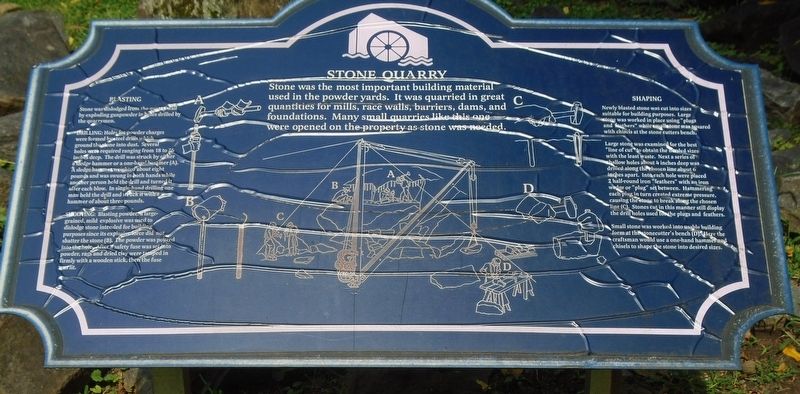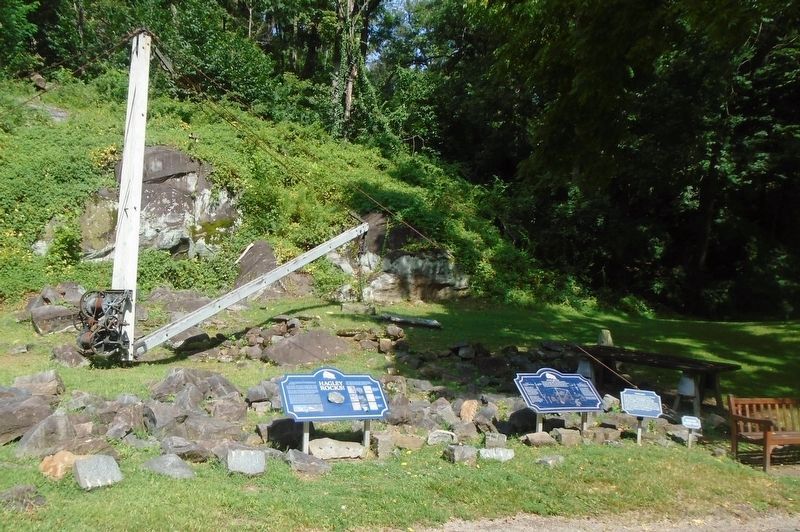Hagley Museum near Wilmington in New Castle County, Delaware — The American Northeast (Mid-Atlantic)
Stone Quarry
Inscription.
Stone was the most important building material used in the powder yards. It was quarried in great quantities for mills, race walls, barriers, dams, and foundations. Many small quarries like this one were opened on the property as stone was needed.
Stone was dislodged from the quarry wall by exploding gunpowder in holes drilled by the quarrymen.
DRILLING: Holes for powder charges were formed by steel drills which ground the stone into dust. Several holes were required ranging from 18 to 36 inches deep. The drill was struck by either a sledge hammer or a one-hand hammer (A). A sledge hammer weighted [sic] about eight pounds and was swung in both hands while another person held the drill and turned it after each blow. In single-hand drilling one man held the drill and struck it with a hammer of about three pounds.
SHOOTING: Blasting powder, a large-grained, mild explosive was used to dislodge stone intended for building purposes since its explosive force did not shatter the stone (B). The powder was poured into the hole. After a safety fuse was set into powder, rags and dried clay were tamped in firmly with a wooden stick, then the fuse was lit.
Newly blasted stone was cut into sizes suitable for building purposes. Large stone was worked in place using "plugs and feathers” while small stone was squared with chisels at the stone cutters bench.
Large stone was examined for the best "line of cut” to obtain the needed sizes with the least waste. Next a series of shallow holes about 4 inches deep was drilled along the chosen line about 6 inches apart. Into each hole were placed 2 half-round iron "feathers” with an iron wedge or "plug” set between. Hammering each plug in turn created extreme pressure, causing the stone to break along the chosen line (C). Stones cut in this manner still display the drill holes used for the plugs and feathers.
Small stone was worked into usable building form at the stonecutter's bench (D). Here the craftsman would use a one-hand hammer and chisels to shape the stone into desired sizes.
Erected by Hagley Museum.
Topics. This historical marker is listed in these topic lists: Environment • Industry & Commerce.
Location. 39° 46.739′ N, 75° 34.414′ W. Marker is near Wilmington, Delaware, in New Castle County. It is in Hagley Museum. Marker is at the intersection of Hagley Creek Road and Blacksmith Hill Road, on the right when traveling north on Hagley Creek Road. Marker is on the Hagley Museum grounds, reachable
on foot from the tram stop at the Millwright Shop, after paying the entrance fee. Touch for map. Marker is at or near this postal address: 200 Hagley Creek Road, Wilmington DE 19807, United States of America. Touch for directions.
Other nearby markers. At least 8 other markers are within walking distance of this marker. Stone Boat (here, next to this marker); Hagley Rocks! (here, next to this marker); Site A: Millwright Shop (a few steps from this marker); Millwright Shop (a few steps from this marker); The Powdermen (within shouting distance of this marker); Hercules "Type A" Turbine Water Wheel (within shouting distance of this marker); The Evolution of the Incorporating Process (about 300 feet away, measured in a direct line); J.E. Rhoads & Sons of Delaware Tanbark Stone (about 300 feet away). Touch for a list and map of all markers in Wilmington.
Also see . . .
1. Brandywine River Powder Mills. (Submitted on September 2, 2023, by William Fischer, Jr. of Scranton, Pennsylvania.)
2. Exploring the Wilmington Blue Rocks: A GeoAdventure in the Delaware Piedmont. (Submitted on September 2, 2023, by William Fischer, Jr. of Scranton, Pennsylvania.)
3. Hagley Museum and Library. (Submitted on September 2, 2023, by William Fischer, Jr. of Scranton, Pennsylvania.)
Credits. This page was last revised on February 11, 2024. It was originally submitted on September 2, 2023, by William Fischer, Jr. of Scranton, Pennsylvania. This page has been viewed 69 times since then and 24 times this year. Photos: 1, 2. submitted on September 2, 2023, by William Fischer, Jr. of Scranton, Pennsylvania.

